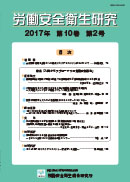Volume 10, Issue 2
Displaying 1-8 of 8 articles from this issue
- |<
- <
- 1
- >
- >|
-
2017Volume 10Issue 2 Pages 73-74
Published: September 29, 2017
Released on J-STAGE: September 29, 2017
Download PDF (217K)
-
2017Volume 10Issue 2 Pages 75-83
Published: September 29, 2017
Released on J-STAGE: September 29, 2017
Advance online publication: August 23, 2017Download PDF (567K) -
2017Volume 10Issue 2 Pages 85-95
Published: September 29, 2017
Released on J-STAGE: September 29, 2017
Advance online publication: September 14, 2017Download PDF (1584K) -
2017Volume 10Issue 2 Pages 97-107
Published: September 29, 2017
Released on J-STAGE: September 29, 2017
Advance online publication: September 12, 2017Download PDF (1269K)
-
2017Volume 10Issue 2 Pages 109-114
Published: September 29, 2017
Released on J-STAGE: September 29, 2017
Advance online publication: August 10, 2017Download PDF (629K)
-
2017Volume 10Issue 2 Pages 115-126
Published: September 29, 2017
Released on J-STAGE: September 29, 2017
Advance online publication: August 31, 2017Download PDF (2200K)
-
2017Volume 10Issue 2 Pages 127-131
Published: September 29, 2017
Released on J-STAGE: September 29, 2017
Advance online publication: July 20, 2017Download PDF (419K)
-
2017Volume 10Issue 2 Pages 133-140
Published: September 29, 2017
Released on J-STAGE: September 29, 2017
Advance online publication: August 18, 2017Download PDF (1027K)
- |<
- <
- 1
- >
- >|
